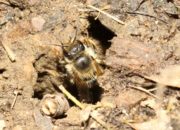This species was introduced to the US from Japan for pollination of apples and other spring blooming fruit. It was first collected in Vermont in 2015, and it is now widely distributed, at least in the warmer parts of Vermont.
A recent paper (LeCroy et al, 2020) correlated the decline of 6 native Osmia in the Mid-Atlantic with a sharp increase of this species (and the similarly non-native Taurus Mason Bee).
Identification:
Roughly Honey Bee sized, this species forms a relatively distinctive group with the Taurus Mason Bee. Both species have black bodies that are covered in bronze hair. The females have two noticeable horns on the front of their face and have orangish-brown scopal hairs under their abdomen, unlike the black or white hairs on the native species.
Similar Species:
Taurus Mason Bee (Osmia taurus) – A closely related and visual similar species. Best distinguished by details of the face.
Status:
Global Status: Secure.
Vermont Status: Introduced
More Information:
For more information on the Hornfaced Bee, visit the following links:
Vermont Distribution
To see the global distribution, check out the iNaturalist account, and toggle the GBIF layer on the map.
 Female Horn-faced Mason © Micheal Veit
Female Horn-faced Mason © Micheal Veit






